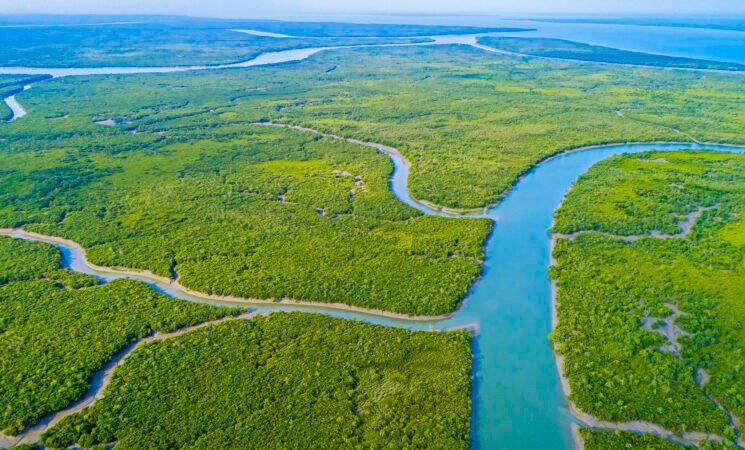9 July 2025, NIICE Commentary 11444
Gandharbika Ghosh
“Indeed, this is perhaps the most important question ever to confront culture in the broadest sense—for let us make no mistake: the climate crisis is also a crisis of culture, and thus of imagination.”
— Amitav Ghosh, The Great Derangement
The Sunderbans Delta, situated at the confluence of the Ganga, Brahmaputra, and Meghna rivers, is the largest contiguous mangrove forest in the world. It spans southern Bangladesh and eastern India. Both sections were declared a UNESCO World Heritage Site owing to the ecological significance, rich and endangered biodiversity including the Royal Bengal Tiger. The Indian part of the Sundarbans (ISD) comprises 9,630 km ² of land, of which about 4,260 km ² is classified as reserved forest. In March 1989 all of the ISD was declared a Biosphere Reserve but the human-inhabited part is not under the jurisdiction of the Director of Biosphere Reserve.
The Sundarbans has been in the spotlight of the global climate crisis, subject to frequent and destructive cyclones, riverbank erosion, rising sea levels and increasing salinization. Given that the region is densely inhabited, these processes have set forth new forms of displacement, endangering local livelihoods, and catalysing cycles of urban migration.
Over the years, the Sunderbans has witnessed intensified conservation interventions—through biosphere reserves, protected areas, and international climate finance initiatives—which, while intending to protect the fragile ecology, have frequently imposed uneven burden on local resource use and mobility. The implementation of climate change mitigation and adaptation (CCMA) policies in developing countries have been shown to disrupt the lives of local populations in varied ways depending on their socio-economic conditions. Roy states that when CCMA policies are not grounded in social justice, they can result in substantial benefits for elites at the expense of the marginalized. Policies rooted in the principle of ‘economic efficiency’, often driven by elite interests, has historically led to the dispossession of peasants and made the Sundarbans region ecologically vulnerable. Such policies thereby reproduce exclusionary spatialities. Various scholars like Dayabati Roy contend that the mitigation policies rooted in capitalist ‘growth’ and ‘development’ ideology perpetuate the very vulnerabilities that they demand to address. This portrays how climate change and conservation intersect in the Sundarbans, not as isolated phenomena but as entangled forces that co-produce precarity and displacement.
Climate change in the region is not a neutral phenomenon. It is a political and uneven process, shaped by colonial hydrological legacies, extractive logics, contemporary infrastructural neglect, and technocratic adaptation agendas. Scholars of environmental studies like Dewan, state that in recent times climate change has emerged as a special code or metacode used by “development brokers,” which helps sideline deep socio-environmental challenges at local levels, which exacerbates structural inequalities instead of ensuring sustainable ecological and social justice. Its communities are not just passive victims of natural disasters but are caught in the spiral of environmental governance that simultaneously commodify as well as securitize nature, displace people, and obscure histories of underdevelopment and marginality.
While climate action plans aim for vulnerability reduction and social/environmental justice, their implementation is often shaped by local political forces. Elites play a significant role in shaping climate change and conservation plans by framing these issues in ways that can legitimize their actions. The 2014 World Bank report on climate change coping mechanisms emphasised the need for both grey and green infrastructure. In the absence of alternatives, infrastructures like embankments serve as the primary protection against disasters in the Sundarbans. Studies have shown how the construction, maintenance and repair of these structures are marred by electoral politics and political and economic incentives, thereby transcending as disaster mitigation structures to symbols of ‘governmentality’ — the exercise of governmental power and authority. The interpretation and implementation of forest conservation and disaster management policies in the Indian Sundarbans affect various social groups differently based on their location and socio-economic status. Political and elite interests impact disaster mitigation and recovery strategies, leading to a contradiction between intended outcomes and actual experiences.
The political-economic strategies at state and local levels create an “institutionalized political impasse” that undermines climate action. The disaster management plans are marred by ‘climate politics’. Political and economic drivers often subvert effective climate action strategies. Climate actions are sometimes only symbolic, lacking an in-depth understanding of local environmental and social complexities. The heavy presence of electoral politics affects crisis scenarios and post-disaster recovery efforts. This results in local institutions failing to effectively respond to community needs and to centralized authorities responsible for disaster mitigation. The focus on visible costs like loss of life and infrastructure by media, government, and policymakers often neglects the deeper dimensions of vulnerability, stress, and marginalization experienced by certain communities.
Roy, through her research, finds that the peasants and fishermen know that climate change is not something ‘out there’ that they have to adapt to. These communities have consistently been trying to cope with the changing environment that has been actively yet unevenly produced. The notion of economic efficiency in climate change and conservation policies has historically led to the dispossession of peasants, impacting ecological sustainability and making the Sundarbans ecologically vulnerable while also weakening social justice. The government's development agenda has led to landscape changes that significantly alter the ecosystem and biodiversity, creating a livelihood crisis for marginal people and wildlife alike. Roy, for instance, states that the government has replicated and promoted the agricultural model, which has increased the growth in production in major parts of the state of West Bengal and in the country, in a similar fashion in the ISD, a declared biosphere reserve. It was not attuned to the topography and the ecological means of the region. The more the state implements these projects, the more it integrates the islanders with itself. The more the islanders integrate with the state, the more nature would disintegrate its system.
A key issue is therefore, the development agenda of the government institutions, climate politics and the focus on ‘economic efficiency’. Instead of focusing on conserving and regenerating forests, these policies tend to regulate and restrict the lives of forest dwellers. As a result, many local people have been displaced from the lands and forests that they have depended on for generations. Vast forest areas have been cleared and repurposed, deepening the economic vulnerability of already marginalized groups and eroding social justice. These changes have not only disrupted local livelihoods but also harmed the region’s ecosystem and biodiversity. The rights of the local communities, forest and biodiversity protection thus seem to depend on arbitrary government policies. To move toward true climate and social justice, existing forest conservation and forest rights laws need urgent reform. A genuine climate and social justice legislation requires a serious rethink of current forest conservation acts and forest rights acts.
Conclusion
While conservation efforts aim at protecting forests and wildlife, they often result in the dispossession of local communities and harm to both human and non-human populations. They often reproduce exclusionary logics, turning forests into zones of exception where human life is regulated or rendered disposable. Reframing the Sundarbans not only as a site of ecological urgency but also of historical injustice and everyday resistance opens space for more ethical and equitable policy interventions which need to be embedded in the logics of sustainability, and environmental as well as social justice.
Gandharbika Ghosh is a Research Intern at NIICE and is currently pursuing her M.A. in Political Science at the University of Delhi, India.

